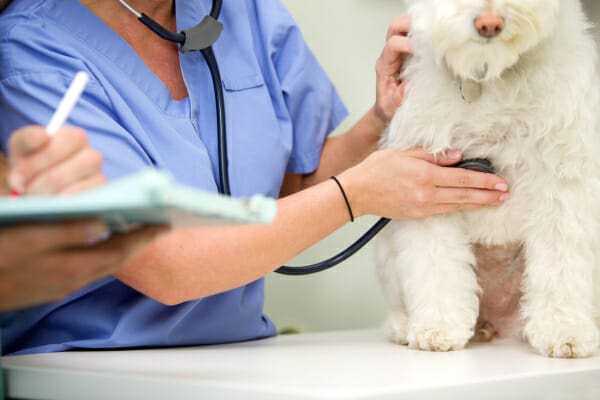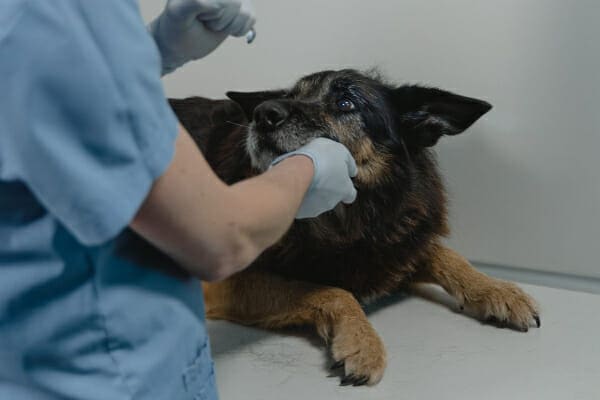There aren’t many things in life more gut-wrenching than taking your beloved dog for an emergency vet visit. However, accidents and illness can strike at any time. To help you feel more prepared if the unexpected does happen, integrative veterinarian, Dr. Julie Buzby, invites emergency veterinarian, Dr. Kathryn Williams, to share some wise words of advice. Equip yourself for an emergency—for the best possible outcome for your dog.

You arrive at the dog emergency room. Your beloved dog is sick or injured, and you are worried. Plus, your dog may be receiving care from an emergency veterinary team you have never met. It’s enough to make even the most stalwart dog parent overwhelmed and anxious. However, as an emergency veterinarian, I’d like to reassure you that there is an entire veterinary emergency team dedicated to giving your pup the best possible care. We’re here to get your dog (and you) through this crisis.
As a proactive dog parent, it may be reassuring to know that there are some ways you can help make the emergency room visit run as smoothly as possible for everyone—especially for your dog.
What are some signs that my dog needs emergency veterinary care?
First, let’s make a plan for determining what constitutes a veterinary emergency. Does your dog need to be seen by an emergency vet? Sometimes this is a very straightforward decision, but other times it isn’t quite as clear cut.
In general, if any of the situations or signs listed below describe your dog, you should bring him or her to an emergency vet immediately:
- Trouble breathing: This includes increased coughing, abdominal effort to breathing, rapid breathing, or blue/purple gum color. Any of these signs may be due to heart disease in dogs, laryngeal paralysis in dogs, collapsed trachea in dogs, or several other conditions.
- Collapse or significant weakness: This is a sign of an emergency, and may be related to stroke in dogs, IVDD in dogs, spinal stroke in dogs, or many other conditions.
- Toxin ingestion: I highly recommend calling ASPCA Animal Poison Control Center either before or on your way to the vet hospital. The ASPCA can provide the veterinary team with critical advice regarding treatment. There is a fee associated with this service, but the information is well worth the money.
- Injuries: Some common emergency injuries include bites, being hit by a car, bleeding, broken bones, sudden limping, and eye injuries.
- Severe pain
- Snake bites
- Swollen abdomen: This condition may be a sign of life-threatening bloat in dogs or internal bleeding.
- Vomiting or diarrhea
- Heat stroke in dogs
This is not an exhaustive list. If you think your dog’s condition is serious, it is better to play it safe and head to the emergency room.

What should I do before I go to the emergency vet?
Next, you can do a bit of quick preparation that can help the veterinary team treat your dog.
- If you have copies of your dog’s records, bring them along with you. Often, emergencies happen at the most inconvenient times—weekends, holidays, or middle of the night. In those cases, you can’t access your dog’s records at your regular vet unless you happen to have copies at home. Other times, an emergency happens during your regular vet’s business hours. You may still end up going to the emergency clinic if your vet thinks your dog needs the intensive care available in a veterinary emergency room. In that case, see if your vet can fax the emergency clinic a copy of your dog’s vaccine records and recent medical history.
- Call the emergency clinic to let them know you are on your way. Also, let them know what time you think you will arrive. That way, if it is a life-threatening emergency, a veterinary professional can be on standby.
- I also recommend either keeping a list of your dog’s medications on your phone or, in the event of a crisis, tossing the bottles in a ziplock bag and bringing them with you. The labels have all the information your emergency vet will need. It is important for your emergency vet to know which medications your dog is currently taking. This information helps prevent unwanted interactions between different medications.
What will my emergency vet need to know when I get there?
When I was a new veterinarian fresh out of school, my boss gave me a copy of Every Patient Tells a Story: Medical Mysteries and the Art of Diagnosis by Lisa Sanders. The book highlights how much information can be gleaned from the patient history. In other words, how you tell your dog’s story and how you answer the vet or tech’s questions are critical pieces that you can provide on behalf of your dog.
During an emergency, it is likely you will tell your dog’s story to the veterinary technician triaging your dog and then to the emergency vet. In fact, it may feel like you are telling your dog’s story constantly. Here’s why:
The history you provide to the veterinary team provides crucial background information that can help rule in or rule out different conditions. Sometimes you might think of something relevant to the situation the second time through that you didn’t mention the first time. Every clue you share is valuable to your veterinary team who is listening to your account to make an accurate diagnosis.

When telling your dog’s story, include the following information:
- When did the problem start or when was your dog last behaving normally?
- Has your dog had any previous health conditions?
- What medications is your dog on?
- What symptoms are your dog experiencing?
- Has your dog had a diet change or gotten into anything he or she shouldn’t have?
- Has the problem happened before or is this the first incidence?
- Is your dog up to date on vaccines and parasite preventives?
What can I expect during the emergency room visit?
Upon arrival, a veterinarian or technician will likely triage your dog. This is a quick exam that allows the team member to gather basic information like temperature, heart rate, respiratory rate, and gum color. The vet or tech will use that information to determine how urgent your dog’s situation is.
If your dog is in critical condition, he or she will move to the front of the line. If your dog is stable, he or she will probably have to wait their turn in line. While waiting in line to have your sick dog seen can be incredibly stressful, please understand that triage is a competition you do not want your dog to win. “Winning” at triage means your dog is very close to death.
When it is your dog’s turn, the veterinarian will either call you on the phone or talk to you in the exam room. This is based in part on whether the emergency hospital is providing curbside service due to COVID. The veterinarian will discuss the diagnostic and/or treatment plan with you before going forward.
Once you agree on a plan, the veterinarian will perform the needed diagnostic tests or treatments. This may take a couple hours so please be patient. If your dog is staying in the hospital, the veterinary team will likely place a catheter into the vein to help provide fluids and other medications.
Most veterinarians are pet parents, too. We understand how hard it is to be away from your dog. The veterinary team will do their best to keep your dog comfortable while in the hospital. Also, your dog will be monitored closely by the highly skilled team (and probably get some cuddles along the way too).
The top 10 things you should know about a visit to the emergency vet
Now that you have an idea of what to expect at the emergency hospital, I want to share the top 10 things that I wish every dog parent knew before coming to the emergency clinic. I have mentioned parts of some of them above, but they bear repeating.

1. Understand you may have a long wait. Bringing things to keep you occupied can help.
Currently, most emergency hospitals are swamped with critical and non-critical cases. This is why triage is so important. It ensures critical patients can move to the front of the line. However, if your dog is stable, this likely will mean a long wait. In the region where I work, wait times are commonly six to eight hours.
Having to wait doesn’t mean we don’t think your dog is important. It simply indicates that the veterinarians and staff are working as hard as they can to provide excellent medical care to a large number of pets who need help. Now is a great time to catch up on a podcast or book on tape while you wait. Or get some knitting done, take a nap, read a book…you get the idea. If you plan to use your phone a lot, make sure you have the charger too. (See #4 for why this is important.)
2. While waiting can be stressful for you, it’s actually a sign that your dog isn’t on the verge of death.
I understand it is incredibly stressful waiting for hours without knowing what is wrong with your beloved dog. It is probably worse when it seems like someone “jumps the line” when you have been waiting patiently. Please bear in mind that in order to skip everyone else who is waiting, your dog has to be on the verge of death. So, if your dog was determined to be stable, rest assured he or she will be seen—and be thankful that he or she is stable enough to wait.
3. Answer the veterinary team’s questions honestly.
When I’m taking a history, it’s quite common for an owner to insist they don’t give table scraps even though they really do. In other cases, a pet parent is reluctant to disclose that the dog could have gotten into something like marijuana for fear of being judged or being reported to police (if it is illegal in that state).
Your veterinary team is not looking to judge you or punish you. They just want to help your dog. So, if you gave your dog some bacon or if he or she got into some edibles, please be honest. Eventually the truth comes out, and keeping secrets only delays care for your dear dog.
4. Keep your phone charged and accessible so you can answer when the veterinary team calls.
Many hospitals are still using curbside medicine to prevent their doctors and staff from COVID exposure. This may change in the future, but for now, phone calls are our main means of communication. Please make sure you answer your phone when we call. Waiting to answer your phone or playing phone tag can delay treatment.
If your phone has an app that blocks unrecognized numbers, please disable it temporarily so that we can reach you. Try to conserve your phone’s battery. Or bring along a phone charger that plugs into your car to ensure it doesn’t die.

5. Designate one contact person who will make the medical decisions for your dog.
Having one point of contact can streamline communication. This is especially important when you and the veterinary team need to work together to make critical decisions quickly. If you are out of town, please ensure the pet sitter has your contact information. Alternatively, give him or her the information for whomever you have authorized to make medical decisions for your dog.
Likewise, if your teenager is bringing your dog to the veterinary hospital, please have him or her provide your name and contact information if you will be the one making medical and financial decisions for your dog. It’s significantly easier for the doctor to talk with the individual responsible for decisions directly instead of playing telephone with multiple people.
6. Understand that emergency care can be expensive and know your financial options.
Staffing a 24-hour emergency hospital is costly. The hospital needs to pay doctors, techs, assistants, and receptionists overnight, weekends, and holidays to ensure someone is there to help your dog all the time. Remind yourself that your dog is getting the benefit of specialized emergency critical care, which is very valuable (and sometimes life-saving).
Keep in mind too that especially in an emergency situation, the doctors need to run tests to identify the problem and determine how serious it is. Otherwise, they may not know how best to treat what is going on with your dog. Please be honest with the staff on your financial limitations. We are all human and we get it. There is no judgement or shame in saying, “Here is what I can afford right now. What are my options?”
The good news is that many emergency hospitals will accept CareCredit, which is a credit card for medical expenses. Depending on how much you need to borrow, CareCredit will usually allow you to borrow interest free for 6 to 12 months. This can be a helpful way to cover the care your dog needs during an unexpected veterinary emergency visit.

7. Invest in pet insurance so you will be prepared if emergency strikes.
As we have discussed, veterinary emergencies can often be expensive. When I worked in general practice, I would always recommend my new puppy owners get pet insurance. Puppyhood is a great time for this because the earlier you can get coverage, the fewer pre-existing conditions your dog will likely have.
Pet insurance can help you afford an emergency bill and take away some of your financial worries so you can focus on your dog. However, an emergency is not the time to enroll in insurance, as the condition will then be pre-existing. This is certainly a situation where an “ounce of prevention is worth a pound of cure.”
8. Bring a list or bag of your dog’s medications and supplements to avoid medication interactions.
It is very important for your emergency vet team to know what medications your dog currently takes. Certain medications, such as prednisone for dogs (a steroid) and non-steroidal anti-inflammatories (such as Carprofen, Meloxicam, Previcox, etc.) can increase the risk of stomach ulcers if used together. Or, if your dog takes medication to control seizures in dogs, it is helpful to know what medication he or she is currently on. That way your emergency vet will know where to start if additional anti-seizure medications are needed.
I recommend keeping a list of medications on your phone with the following information:
- The name of the medication
- The size of the tablet/capsule
- Directions for administration
If you are in a rush, simply throw all of your dog’s medication bottles in a bag. The emergency veterinary team can get the needed information from the labels.
9. Call ASPCA Poison Control Center if your dog ate something he or she shouldn’t have.

As an emergency vet, I love ASPCA Poison Control. Their team of techs and veterinarians are pet toxicology experts. They can tell you what symptoms, if any, your dog may experience if he or she ate something potentially toxic like rat poison, human prescriptions, or chocolate. Additionally, they will also provide your veterinary team with a thorough treatment plan to help your dog through the crisis. (A fee does apply for the service, but it is definitely worth it.)
10. If you are transferring to the ER from your primary vet, please bring a hard copy of the X-rays and/or bloodwork.
There may be situations where your primary vet will transfer you to an emergency clinic for overnight care if your dog has a serious medical condition such as pancreatitis in dogs, pyometra (i.e. uterine infection), or other illnesses. Your veterinarian will likely email or fax records, but sometimes files don’t go through or can be difficult to load. Before you pack up to head for the emergency hospital, ask your veterinarian for a hard copy and/or CD of the tests he or she performed.
Parting thoughts from an ER vet
I understand an emergency vet visit will probably always be a bit scary for dog parents since it means your beloved dog is sick or injured. However, hopefully having an idea of what to expect and keeping these ten tips in mind will make everything go a bit smoother. Know that your pup will be in good hands in the dog emergency room. Everyone there is doing their absolute best to care for your furry family member.

What tips do you have for other dog parents who are facing an emergency vet visit with their dogs?
Please comment below.


I am curious, have you ever had a vet go from 3-6 hours of triage to 12-16? The anxiety is rising as our emergency vet has still not examined our dog who we brought in 5 hours ago for analysis bleeding due to what is thought to be from ingestion of rope and possibly the plastic ball that had been attached. We called well ahead as we live 2 hours away, and we’re told she needed to come in immediately based on symptoms. I guess I’ve never heard of such a long wait. I’ve brought a cat to the old emergency vet here, and with how busy they were, the cat was still examined within 2 hours. Also, do to the distance have been outside the emergency vet the whole time with no additional vehicles coming in other than 2. My dog is one of those that is always happy, even with a pulled muscle she’ll hide it and be happy. Is being told it could now be upto 16 hours before she’s even examined normal?
Hi Desirae,
I am so sorry you are in this difficult situation with your pup. Unfortunately, I really can’t speak for why the wait time is so long at the emergency clinic in your area. It is becoming more common for all clinics to be understaffed and facing a lack of help and trained employees. This may be a factor in your local ER. Also, there are any number of situations that could be happening in the clinic that could have the veterinarian completely tied up. There are usually several critical cases hospitalized on a daily basis. If one (or several) of those cases are in distress, the vet will have to make the call about which pets are most critical and address them first. The situation can change minute by minute and if your dog is stable, then she may end up waiting longer than expected. I know this is a burden for you having traveled from 2 hours away and I understand your worry for your dog’s health and wellbeing. How is your sweet girl feeling today? Did everything turn out ok? Praying all is well and she was able to receive the medical attention needed. Feel free to leave an update if you have a chance.
All of that is good advice. We’ve had two ER trips with our girl; one for a venomous snake bite and the other for raisin ingestion. I already kept a travel organizer with all of her medical paperwork (including her MDR1 diagnosis) and took that in with me both times. When she ingested raisins we called the Poison Control hotline first and went through their protocol. The cost was well worth the call and information.
There are two ER hospitals in our area. We’ve been to both and been very pleased with the quality of care at both. I truly appreciate medical staff who work to keep our pets and us healthy.
Hi Amy,
It sounds like you did a great job having all the needed information for those visits and I am so glad you were pleased with how both visits went. The travel organizer is a great idea and having the paperwork about her MRD1 diagnosis in there is so useful for the veterinary team! I’m glad that she recovered from both of those scary situations. Thank you too for your kind words about medical staff. It means a lot! ❤
Your note about long wait times is spot on. Our senior dog had an urgent issue on a Saturday that we were afraid could not wait until Monday to see our regular vet. The ER vet was 45 minutes from our home so we sat in the parking lot to wait to hear from the vet (this was during the pandemic). Ten hours later we got home. There were 32 cases ahead of ours! I completely understand why we had to wait but my complaint is we were not told of the situation. Had the staff set our expectations- “Just to let you know your wait will be at least 6-8 hours” – it would have been a much less anxious day for us. For hours we sat there saying, do we stay or go home?
Emergency Centers, please set expectations for your clients!
Hi Nan,
Sorry to hear that your senior pup ended up needing to visit the ER. I understand that it can be difficult to wait for your dog to be seen and be unsure how long the wait will be. I think your point is well taken. As you mentioned, the ER clinics are very busy right now and doing their very best to keep up with the massive number of cases they are seeing while trying to take extra precautions to keep the veterinary team and clients safe during the pandemic. I know sometimes things don’t go as smoothly as they would like. I hope your dog has recovered fully from whatever sent you guys to the emergency room and is back to living his or her best life!❤